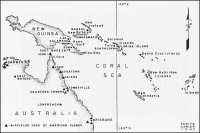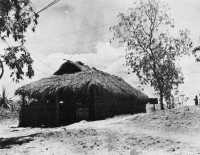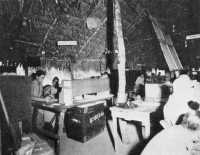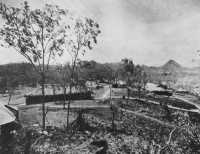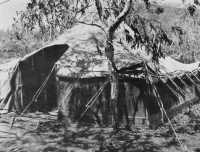Chapter 13: The Problem of New Guinea
Though apprehension for the security of Australia had been considerably relieved by Japan’s withdrawal after the Coral Sea engagement, and though the offensive strength of the Japanese fleet had been seriously crippled at Midway, enemy forces still posed a serious threat to the Allied position in Australia and especially to the line of communications which joined it to the United States. Even in the absence of carrier strength, it would be possible for the enemy to move from Rabaul down the Solomons under cover of landbased aviation and thus to challenge the Allies for possession of New Hebrides, New Caledonia, and the Fijis. Already, in early May, he had occupied Tulagi on Florida Island, seat of the British Resident Commissioner of the Solomons; and early in June, Japanese troops moved across from Tulagi to the Lunga Plain of Guadalcanal, where they would begin construction of an airfield destined to fame in American military annals as Henderson Field. At the same time, he held Lae and Salamaua on the Huon Gulf, and from there it was a relatively short jump to points on the Papuan coast, whence, as events would soon prove, he might even attempt the seizure of Port Moresby by a land attack. The Japanese navy had sustained its initial defeats, but the army as yet had suffered no reverse. Moreover, the successful termination in May of the Japanese invasions of Burma and the Philippines obviously would release additional forces for the enemy’s use. It was evident that some limited offensive action by the Allies would be required in order to make secure the defenses of the South and Southwest Pacific.
There could be no disagreement on the necessity for such action, but in the discussion of measures to be taken there naturally developed
a variety of conflicting views. The claims of the Pacific war as against those of the European war inevitably were involved, and tended to find expression in differing views of the Navy and the Army. To the latter, it was of vital importance to avoid commitments extending beyond actual requirements for the defensive strategy agreed upon for the Pacific, a view wholeheartedly shared by leaders of the Army Air Forces, who looked forward to the mounting of an early air offensive against Germany. General MacArthur’s position as the responsible commander of the Southwest Pacific led him to form opinions that were held in common with similarly responsible naval commanders who faced the Japanese across the broad reaches of the Pacific Ocean,1 but the division of command between the Army and Navy in the Pacific naturally made for differences of viewpoint. A final settlement of all of the issues involved could not be reached at this time, but a working agreement on immediate action was achieved, an agreement, moreover, which left the way clear for an early offensive against Germany.
Plans for Limited Offensive Action
General MacArthur now had in his command two American infantry divisions, the 32nd and the 41st, which together with the veteran Australian 7th Division provided the nucleus of a ground army, though there were serious deficiencies of training and equipment. At the same time, he keenly felt the need for additional naval forces, including two carriers, and of another infantry division especially trained for amphibious assault; for he proposed to undertake a northward thrust from Australia by way of New Guinea against the enemy at Rabaul.2 His ideas were not without support in Washington, where, for example, the Assistant Chief of Air Staff, Plans, Col. Orvil A. Anderson, had in preparation a study of the possibility of a conquest of Rabaul through operations based upon the principle of a progressive achievement of air superiority over intervening land bases. A considerable development of air facilities in northeastern Australia and around Port Moresby, together with control of the air in those areas, initially would be required. Then, with “complete air supremacy” established over the approaches to New Britain, it would be possible to seize Lae, Salamaua, and Gasmata by an airborne task force, and thus to move forward Allied fighters and dive bombers in preparation for an amphibious assault on Rabaul with the cooperation
of both land-based and carrier-borne planes.3 It was an ambitious proposal, indeed too ambitious for the means then at hand, but it indicated a line of thought in the War Department that on broad principle would be favorable to General MacArthur’s immediate proposal and to the development of tactics he would subsequently follow in the Southwest Pacific.
But the Navy, apparently concerned over the prospect of committing its forces between New Guinea and the Solomons while the enemy held the latter, objected to MacArthur’s proposal that the New Britain area should be an immediate objective. It had proposed, rather, an initial conquest of Tulagi by South Pacific forces supported by those of the Southwest Pacific.4 The introduction of this alternative into the discussion posed, among other difficulties, a knotty problem of command; for Tulagi under the original directive to MacArthur fell within the Southwest Pacific, and it was evident that the Navy anticipated that, even so, it might control an operation to be mounted in the South Pacific against the Solomons. Such a command arrangement, in fact, had become formally a part of the Navy plan by 29 June, when Admiral King submitted to the Joint Chiefs a proposal that Vice Adm. Robert L. Ghormley, who had been in command of the South Pacific since 19 June, should be given command of an operation for seizure of Santa Cruz and Tulagi on the understanding that General MacArthur would assume control of its subsequent development into an attack on the Japanese position in New Guinea and New Britain.5
Though MacArthur had protested that his own plan for direct action against Rabaul presupposed the establishment of an air supremacy that would remove the grounds of the Navy’s objection, and though he warned against the dangers of divided command, Admiral King’s proposal offered the basis of a workable compromise.6 Accordingly, on 2 July the Joint Chiefs issued a directive which defined their policy with reference to the Japanese threat in terms of three tasks.7 Task one, the occupation of Santa Cruz and Tulagi, would be executed under the command of Admiral Ghormley with such support from air and naval units of the Southwest Pacific as could be rendered. To remove jurisdictional uncertainties which might per the effort, the boundary between the South and Southwest Pacific theaters would be moved westward as of 1 August to the 159th meridian, a line that would place within the South Pacific all
of the lower Solomons. Task two, under command of General MacArthur, would involve seizure of the upper Solomons and of Lae, Salamaua, and the northeast coast of New Guinea. The way then would be prepared for task three, which was the seizure, again under MacArthur’s command, of Rabaul and adjacent parts of New Britain and New Ireland. Control over the composition of forces, the timing of each task, and the “passage of command” would remain with the Joint Chiefs.8
Thus did the American chiefs of staff set the stage for the bitter drama to be enacted on Guadalcanal, where the Marines would land on 7 August. If the Army had yielded to the Navy’s persuasion regarding strategy in the Pacific, its own strategic concept of the war as a whole remained official policy. General MacArthur had been forced to surrender the hope of attack in strength on the enemy to the north, but that enemy nevertheless would be heavily engaged over the ensuing months. Meanwhile, the Southwest Pacific command would be free with available forces to undertake appropriate steps preliminary to the inauguration of operations in fulfillment of task two.
The Operational Record of May and June
Since one of the prerequisites to an undertaking of task two was the ability to assert control of the air over upper Australia and the lower extent of New Guinea, there was a good deal of reassurance to be found in the recent record of Allied air operations. The bombers were still forced to operate from bases well to the rear, and to stage through Port Moresby for attacks on Lae, Salamaua, and Rabaul. But Allied intelligence indicated an approximate balance between our own and enemy forces in the general area of combat. On 19 May the Japanese were credited with forty-five fighters and forty bombers in New Britain and New Guinea, and with a comparable number divided between Timor and Bali, as against an over-all total of 302 American fighters (operational and inoperational) at the end of May. The figures were substantially unchanged two months later, though 167 enemy planes credited to Celebes were obviously within easy reach of either Timor or Bali. On 18 July the Americans had in the combat area eighty P-40’s of the 49th Group stationed at Darwin and eighty-three P-400’s belonging to the 35th Group, two of whose squadrons were based at Port Moresby.9 The enemy still enjoyed
Map 22: New Guinea and the Solomons
obvious advantages in the reinforcement of his outlying bases, but even leaving out of account the limited strength of the RAAF, the Allies no longer faced overwhelming odds in the defense of their outposts.
The lack of adequate air warning facilities still proved a discouraging factor. RAAF radar equipment, having only a fifty- to seventy-five-mile range, was quite unsatisfactory, and five SCR-270’s which had been emplaced in Australia were the only American sets available at the end of April. As a consequence, a considerable reliance had to be placed upon spotters in the hills and coast watchers – Australians, for the most part, who risked their lives in the remote areas of New Guinea, New Britain, and the Solomons to watch and send by radio a warning of enemy activity – who would render such distinguished service throughout the Solomon and New Guinea campaigns.10
Progress had been made in the development of tactical skills, which helped to overcome the disadvantages of inadequate warning and certain superior qualities of the enemy planes. The 49th Fighter Group in its defense of Darwin had compiled a very creditable record. Prior to May it had lost seven of its P-40’s and three pilots while destroying an estimated total of 38 Japanese planes and 135 crewmen. The heaviest enemy attack had been executed by twenty-four bombers escorted by nine fighters, and this attack had been met by fifty P-40’s whose pilots claimed eleven of the enemy aircraft. During May, Darwin, for a change, remained free of bombing. The enemy returned on four consecutive days in June, his largest mission comprising twenty-seven bombers and eighteen fighters which were intercepted by twenty-eight P-40’s, and the final score for the month stood at nine P-40’s against thirteen enemy losses.11 Though the Japanese still could get through to Darwin, it was costly.
A substantial part of the credit must be assigned to the skill of ground crews and other service personnel. By dint of their energetic efforts Col. Paul B. Wurtsmith, commanding officer of the 49th Group, could usually count on having sixty P-40’s in commission, with the result that his pilots were rarely outnumbered. Probably of greater significance were the conferences held after every engagement for the purpose of perfecting combat techniques that would overcome the inferior “speed, maneuverability, climb, and ceiling” of the P-40. As a result the two-plane element had been fixed upon as the chief reliance in combat, individual dogfighting had been outlawed,
pilots had been instructed to attack only with an altitude advantage, and to repeat the attack only under the most favorable circumstances. As a result the inferior characteristics of the P-40 were minimized, while the pilot capitalized on its superiority in armament and diving.12
Lt. Col. Boyd Wagner, who had been appointed director of pursuit in the Moresby area, faced a still tougher assignment. Trained service units were lacking; engineering equipment and maintenance supplies were critically low; and the P-39, even in a good state of repair, was unable to meet the Japanese fighter on equal terms. The P-39’s leakproof tank, rugged construction, and heavy firepower were popular characteristics, but the superior maneuverability, greater acceleration, and higher ceiling of the enemy’s plane enabled him to avoid combat almost at will.13 Late in May the first flights of the 35th Group, equipped with P-400’s, arrived to relieve the pilots of the 8th Group, who in June returned to Townsville to recover from dengue fever, malaria, and fatigue. During May alone Moresby had been attacked twenty-one times. Though some of these attacks were slight, one had been carried out by thirty-four bombers and fifteen fighters with considerable damage to the Seven-Mile Airdrome.14
That most of the enemy’s raids on Port Moresby did little damage was hardly because of the intrinsic merits of the P-39 and P-400. The threat of interception and a gradual improvement in antiaircraft defenses in the area tended to keep the enemy’s bombers high; more than forty of his planes had been shot down; and during June and July the scale of his effort was reduced. The cost to the Americans, however, had been high. Prior to June, twenty to twenty-five P-39’s had been lost in combat, eight more in forced landings, and three by destruction on the ground. The sources are contradictory, but fighter losses at Port Moresby seem to have declined somewhat during June and July.15
In addition to the defensive tasks assumed and a few offensive sweeps, the fighters at Port Moresby also provided escort for transport planes on flights to the primitive airfield of Wau in North East New Guinea. There a band of miners and prospectors, reinforced by a small but specially trained Australian commando-type unit and known as the Kanga Force, held out against a larger force of Japanese who had advanced inland from Lae and Salamaua. By way of a circuitous water and land route, the Kanga Force received supplies at
the rate of about three tons of cargo a week. Since this force represented the only ground unit, aside from guerrillas, actually engaged in fighting the enemy, it was decided to supplement its supplies and to provide reinforcements by air transport with a view toward launching an attack against Lae and Salamaua. This project was somewhat delayed by bad weather and inability to provide fighter cover, but on 22 May a flight by the 21st Troop Carrier Squadron inaugurated a movement of about 300 troops and supplies. For more than a year thereafter, the rough and sloping 3,300-foot runway at Wan served as the most advanced terminal of Southwest Pacific transport operations. At the close of June, the small force at Wau even undertook raids on the Japanese positions at Lae and Salamaua.16
Efforts to make Lae and Salamaua as untenable for enemy bombers as was Port Moresby for Allied bombers had been inaugurated by the A-24’s of the 8th Squadron at the opening of April. But prior to their withdrawal at the end of May to Charters Towers, the A-24’s flew only four combat missions, totaling twenty-nine sorties, from Port Moresby. Though only two were lost in combat as against claims of six enemy planes destroyed on the ground and two shot down, operational losses were high. On 4 April, of the forty-two dive bombers assigned to the Allied Air Forces, only twenty-two were in commission; two months later, only twelve out of twenty-six.17 Designed originally as a carrier-borne plane and seemingly unequal to the rough wear of imperfect fields, of relatively short range and slow speed, and highly vulnerable except when provided with better escort than was possible at Port Moresby, the A-24 was written off by AAF personnel as unsuited to the type of operations required in New Guinea, perhaps mistakenly in view of its subsequent record in Navy hands.
Not unnaturally, the AAF came to place greater confidence in the more rugged B-25. The early “C” model of the Mitchell Army bomber had approximately three times the range of an A-24, could carry more than twice its bomb load, had two more .50-cal. machine guns, and was faster. Ever popular with Army flyers and locally dubbed a “luxury liner,” it proved well suited to the hazardous flights across the Owen Stanley Mountains. The only trouble was that there were not enough B-25’s. Only fourteen originally had been available under the Dutch contract, and by August there were still only seventeen on hand.18
Between 24 April and 4 July, seventy B-25 sorties were flown against Lae and Salamaua, to which number there were added eighty-four B-26 sorties, forty-five by B-17’s, and twenty by RAAF Catalinas, Beauforts, and Hudsons. Insofar as was possible, the bombing efforts of the several units were coordinated, as when, on 16 May, fourteen B-25’s and four B-26’s destroyed buildings, set fire to fuel dumps, and damaged grounded aircraft at Lae. On 9 June, five B-25’s, eleven B-26’s, and two B-17’s bombed the same target through an overcast; and on 16 June, nine B-25’s, ten B-26’s, and three B-17’s scored hits on runways and buildings. It was difficult to ascertain the damage done. The weather was frequently unfavorable, and the Japanese skillful at camouflage. Photographic reconnaissance indicated that bombs often fell wide of the target, and the enemy continued to add new taxiways and dispersal areas. But the Japanese never at any time based their bombers in appreciable numbers at either Lae or Salamaua, and that was what counted. Indeed, Allied estimates, based in part on information supplied by an RAAF officer who spent months within sighting distance of Lae, indicated that enemy fighters based on New Guinea rarely numbered more than forty.19 These were enough, however, to maintain a stubborn defense. Between 24 April and 4 July, three B-26’s and eleven B-25’s were lost in combat. Especially heavy were the losses to an interception of 24 May. Eight B-25’s of the 13th Squadron led by its commander, Capt. Herman F. Lowery, and flying as usual without escort, cut through a pass in the mountains, swept wide of Salamaua, and turned in toward Lae from the east to be met head-on by a strong force of enemy fighters. Six or seven of them were shot down, but Captain Lowery’s plane burst into flames and dove into the ocean, and one by one four other B-25’s went down. A sixth bomber crash-landed on its return to Moresby.20 As with the heavy bombers, Moresby served the mediums only as a staging point.
More of the B-26’s would have been available for strikes at Lae and Salamaua had it not been for the fact that during April and May the 22nd Group assumed a major responsibility for the run to Rabaul. This, of course, was a job for the heavies, but on 2 April the 19th Group had but six aircraft in commission, and through May and June would average no more than seventeen B-17’s ready for combat, or less than half its assigned strength. Moreover, one of its four squadrons, the 435th, was reserved for reconnaissance duties, and repeatedly
flew two missions a day for this purpose over New Guinea and New Britain and on occasion to the Solomons and the Netherlands Last Indies. Indeed, reconnaissance flights continued to levy heavily upon the bombers of all classes available for offensive operations; even the 3rd Group’s B-25’s flew better than 120 reconnaissance sorties in the month of May, when the presence of the enemy’s fleet in the Coral Sea created a special demand for this type of service.21 The B-26’s were based in the Townsville area, and for the mission to Rabaul each plane was fitted with a 250-gallon bomb bay tank and took on a bomb load usually of 4 x 500-lb. bombs or 20 x 100-lb. bombs prior to the 600-mile flight to Port Moresby. Having arrived there, preferably about dusk, an advance detachment of the group readied the planes for the next day’s mission under cover of darkness. They would take off in the early morning, unless the start was delayed for the purpose of confusing the enemy’s defense, and normally would follow a route that took them for forty or fifty miles along the New Guinea coast, then across the Owen Stanley range at approximately 7,000 feet, and through equatorial weather which frequently proved as dangerous as enemy fighters. Over Rabaul, the Marauders made their runs at something under 10,000 feet, after which they turned for the 1,300-mile flight, broken again at Moresby, to their bases.22
Between 6 April and 24 May, the 22nd Group completed sixteen missions for a total of more than eighty sorties against Rabaul. Hits were claimed on three transports, two merchant vessels, and one aircraft carrier in addition to the destruction of at least sixteen aircraft on the ground and ten in the air. The targets provided by the Lakunai and Vunakanau airfields and the near-by harbor were vital ones, but the distances were actually too great for the B-26. The last mission was flown on 24 May – indeed it would be October 1943 before Rabaul was attacked again by medium bombers – and the job was turned over entirely to the heavies. During April, May, and June the 19th Group itself mounted eighteen missions against Rabaul for a total of approximately sixty sorties. Though unfavorable weather and darkness often prevented anything like an accurate assessment of results, gratifying fires and damage to at least two vessels were reported.23 Bombing missions to Rabaul, as to other points, also served in a highly important way the ends of reconnaissance.
Through these months there had been few antishipping strikes, except during the Coral Sea action of May and against vessels lying
Headquarters, 35th Fighter Group, Port Moresby, 1942
Headquarters, 35th Fighter Group, Port Moresby, 1942
Headquarters, 35th Fighter Group, Port Moresby, 1942
Headquarters, 35th Fighter Group, Port Moresby, 1942
at Lae, Salamaua, and Rabaul. Presumably, the best-equipped plane at the disposal of the Allied Air Forces for this purpose was the A-24, but its range did not carry to the main routes of enemy shipping at this time. The B-17 had the range, but the normal priority assigned to counterair operations and the special priority given to reconnaissance left few planes for the purpose. Moreover, pilots trained in high-level bombardment showed no inclination to experiment with low-level attacks. In anticipation of an expected need, a detachment of the 22nd Group went through some training with especially equipped B-26’s in torpedo-dropping, but they never would be put into combat.24
All told, the record was spotty, but there was much to support General Arnold’s contention during the summer and fall that, given a complete build-up of the assigned forces, the Pacific commands possessed enough air strength to hold the Japanese.25 Certainly, the Allied Air Forces was holding its own; at no time since April had the Japanese enjoyed numerical superiority, and this despite departure of some AAF units to strengthen the South Pacific. From April to mid-July, American units lost in combat sixty-one fighters and twenty-two bombers, an additional ten bombers and one fighter on the ground to enemy action, and the depressing total of fifty-four fighters and twenty-three bombers to accidents. During the same period, claims were made for more than eighty Japanese planes shot down; others were destroyed on the ground, and there is reason to believe that unrecorded planes were lost as a result of combat damage on the way back to their bases. It also seems to be a reasonable assumption that operational losses were high.26 A discouraging factor to American airmen in the Southwest Pacific was the delay in the arrival of reinforcements and replacements. Here the enemy, with interior lines of communications, presumably had the advantage. The arrival of American fighters and short-range bombers depended on the critical item of shipping, and even the bombers arriving by the ferry route came in more slowly than had been expected. There was cause for foreboding in figures which showed that during May and June 106 fighters and 42 bombers had been lost, while gains listed no fighters and only sixty-two bombers.27 But American production was now reaching a point that soon would permit it to provide the remedy.
Another cause for concern was the unsatisfactory state of morale.
Virtually all operations were flown from areas that were remote from the more thickly settled sections of Australia; living conditions were primitive, the food was chiefly an unfamiliar Australian ration, the incidence of dengue fever and malaria was high, and facilities for hospitalization and recreation were more than inadequate.28 In these circumstances, the strain of unusually difficult operations took a higher toll. Personnel who had fought through the Philippine and Java campaigns suffered effects of fatigue that at times approached a defeatist attitude; even those who had flown their first combat mission in April had to fight a feeling of disillusionment. Long overwater flights, the dropping of a few bombs with unobserved results, the loss of friends to combat and accident, the lack of opportunity for leave and rotation, the slowness of promotion, and a rather confusing system of operational control, all added up to a trying experience that seemed to have little if anything to do with the outcome of the war. Personal relations with the Australians were generally excellent, for the two peoples had much in common, but the American flyer tended to resent the extent of RAAF control and to find in its administrative forms, as with any unfamiliar government form, a ready source of grievance.29 With the inevitably limited perspective which modern war imposes upon the individual participant, dependent upon the leadership of officers who often were as yet young and inexperienced, and lacking the assistance of effectively organized informational services, he had trouble in assessing his own part with reference to the whole or even in recognizing that he and his immediate fellows were beginning to function like a team.
Responsible officers were alert to these and other needs, and some of them had occasion for satisfaction with the progress made.30 Air Services still suffered because of an insufficient number of trained personnel and the necessity of resorting to cannibalizing aircraft in order to get spare parts, but through the agencies of the Australian government an increasingly effective liaison had been established between the Allied command and Australian industry. Some parts and very helpful maintenance facilities were now available from Australian sources. It was possible to provide a complete overhaul for all types of American engines. With local assistance in the pro vision of materials and tools, the supply and maintenance section of Air Services, under Col. Carl Connell, was pioneering in the design and development of a fifty-gallon steel interchangeable belly tank for
the P-40, P-39, and P-400, of special suspension gear for bomb shackles on the same planes, and of interchangeable bomb bay tanks for the B-26 and the A-20. Labor was more readily available, and gratifying progress marked vital construction in the advanced area.31 A beginning made on the improvement of airstrips in the north, together with the prospect for better maintenance, carried the promise of reduction in a hitherto appallingly high rate of accident.32
Preparations were still incomplete, but the time had come for a move forward. On 20 July, General Headquarters moved from Melbourne, where it had been located since April, to Brisbane. Air service activities at Townsville were increasing. Additional fields were coming into use on Cape York and around Port Moresby; engineers had reached Milne Bay for the purpose of developing airstrips there, and orders had been issued to secure the area about Buna, farther north on the coast of New Guinea, for a still more advanced airfield that would strengthen the Allied Air Forces in its effort to restrict Japanese activity on the Huon Gulf, and at the same time would place the American planes in a better position to cooperate with our naval forces in the fulfillment of task one.33 But before these orders could be executed, the enemy on 21 July landed at Buna in preparation for a push across the mountains against Port Moresby.
By the time the Marines went ashore on Guadalcanal to begin a fight for the Solomons, the forward movement in Australia had been accelerated to meet a new challenge for the possession of New Guinea. The two contests would be fought bitterly and simultaneously, and from them men would date the beginning of the collapse of the world’s newest empire.
